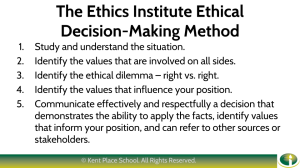The Benefits of Teaching Ethical Dilemmas
Teaching ethics can not only help students become better decision-makers, but it can also help develop crucial academic and social and emotional competencies.
Your content has been saved!
Go to My Saved Content.Ethical decision-making is a crucial part of comprehensive education, but few schools teach ethics, writes Linda Flanagan, advisory board member for the The Ethics Institute at Kent Place School, in a recent KQED Mindshift piece. Introducing ethical dilemmas in the classroom can open up opportunities not only for debate and critical thinking, but also for personal growth, empathy for other viewpoints, and self-reflection.
Effective ethics instruction is about more than distributing a list of moral guidelines; it requires teaching students how to navigate their own moral decision-making. Students learn “to search for and evaluate their assumptions, to excavate the reasons behind those assumptions, to examine without prejudice another’s opinion and to make a thoughtful decision with confidence,” says Jana M. Lone, director of the University of Washington’s Center for Philosophy for Children.
At the Kent Place Institute in Summit, New Jersey, training begins in fifth grade with an introduction to the most basic concepts, like right-versus-right: Students are presented with two seemingly good choices that are in conflict with each other. As kids age into middle and then high school, the lessons become more nuanced and complex.

Using a framework called the Ethical Decision-Making Method as a guide, students in upper grades explore tough issues independently. Middle school students use case studies to apply the framework. In one example, students discuss a young girl named Emma who is not invited to a party but sees her friend Jane at the event on social media posts. The dilemma puts students in a bind, pitting a sense of loyalty against the need to be diplomatic and not unnecessarily hurt a friend’s feelings.
Students reflect on questions like, “How might Emma feel when she sees the Instagram photo? What is Jane’s responsibility in this case? What values influence the way you think about this scenario?” Because the scenarios are fictional but realistic, students are able to freely consider the different perspectives of each character, says Institute Director Karen Rezach.
The students' exploration digs deeper, taking into consideration not only how to make difficult decisions, but how the decisions reflect the underlying values that are important to each student. Middle school students at Kent Place present their findings in different formats—songs, poems and videos—based on the principles they believe are most valuable.
“Once the presentations end, Rezach pairs up students with conflicting ideals—compassion versus justice, for example—and asks them to write a case study together,” Flanagan reports. Eighth-grader Alexandra Grushkin chose integrity, for example, and was paired with a student who chose loyalty; together they crafted a case study that demonstrated the tension between these two values: “What does a student do when she spots her close friend cheating in a school competition?”
The practice not only fosters better ethical decision-making, but it may also have a positive effect on academic performance, says Flanagan. Exercises that require assessments of ethical dilemmas can improve reasoning and critical thinking skills—valuable assets in many academic contexts. Students can apply ethical considerations to historical events, scientific discoveries, and technological or medical developments.
Beyond academics, ethical training develops important “soft skills” like respect, empathy and compassion. “Exploring conflicts from different points of view—and striving to understand the value behind an opinion—also makes them more empathetic to others,” Flanagan writes. Identifying the principles that comprise the foundation of their own beliefs as well as those that guide others allows students to hone social and emotional competencies like self-awareness and social awareness.
